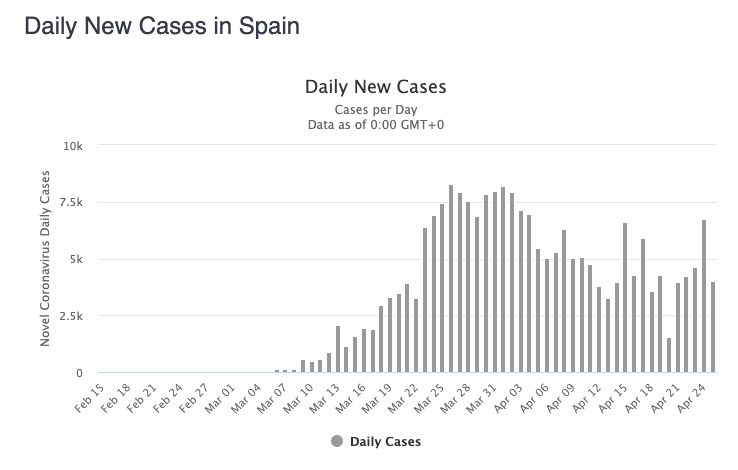The government tries. They try hard. But only the next few weeks will show if they succeed, because Spain has arrived at a crucial point.
Here are the facts and the current situation:
• The first case of infection was detected in the tiny Canary Island of La Gomera in February. Alarm bells should have rung, because neighboring Italy was already showing how serious the virus is and how fast it spreads. On La Gomera, the infected person was quarantined and so was the hotel, but not much more was done.
• Apparently, the alarm bells didn’t ring loud enough because on 8 March, a 120,000-strong feminist demonstration took place on Women’s Day. The virus spread at lightening speed claiming lives and extended to the entire country.
• On 14 March the Estado de Alarma finally was declared, practically shutting down the entire country. Maybe to compensate for the failure to act sooner, the government implemented the toughest rules of confinement in all of Europe.
• From one day to the next, all schools, shops, cafes and restaurants closed. So did the beaches, public parks and promenades, the main venues of exercise and recreation here in Torrevieja, leaving the population not much time to prepare.
• Supermarkets, chemists, tobacco shops and newspaper kiosks remained open as well as a few butchers and bakeries.
Nobody was allowed to leave home except to shop for food, medicine or to walk their dog, albeit only in close proximity to their home. If caught venturing farther afield, they risked heavy fines. Kids weren’t allowed out at all.
Initially, lockdown was declared for two weeks, then extended – now for the third time – until 9 May.
Dr. Fernando Símon, an epidemiologist serving as director of the center for coordination of Health Alerts and Emergencies of the Ministry of Health is in charge of daily briefings informing the country of the development of the crisis and the latest figures. However, it’s difficult to come by the true numbers.
Even Dr. Símon admitted to what he called “the Tuesday holdup.” This means each autonomous province has to report their individual figures, but due to “logistics,” the numbers get delayed or distorted over the weekends.

The most reliable figures are to be found here on Worldometer.
Thankfully, the numbers go down, and one can only hope that trend continues. Meanwhile, back to the situation of the population: After the second extension, construction and production workers were allowed back to work.
Not much has changed here in Torrevieja other than they are tearing up a main road which had only been “repaired” a few months ago. Last week, the mayor of Barcelona, Ada Colau, launched a public appeal to Spanish President Pedro Sánchez to let the children out “now” fearing for their mental and physical health after being kept confined for five weeks, not to mention their parents’ mental health. Residents of Madrid joined in, banging on pots and pans in protest from their balconies.
Finally, he listened and Spanish leadership decided that kids under 14 will be allowed out accompanied by a parent but not without creating some uncertainties. At first, he said they could only go to supermarkets and chemists but then listened to experts who saw no sense in sending kids to one confined space from another and amended it to letting them go for walks with a parent.
Then on Thursday, 23 April, the details were announced: One adult can go out for a walk with up to three kids from the same family as long as the children are all under the age of 14. Between the hours of 9 a.m. and 9 p.m. they can walk, run, jump or ride a bicycle within a radius of 1 kilometer of their domicile for one hour. This starts Monday, 27 April and it remains to be seen how that works out.
As for the rest of us, there are plenty of promises officials will reduce gradually the strict confinement from mid-May onward. But how – and to what extent – nobody knows yet. An added difficulty is that Spain is divided into 17 autonomous provinces plus Ceuta and Melilla. Each one shows a vastly different number of cases, and each one strives to decide their own rules of relaxation according to their individual population and number of cases.
The president, however, is inclined to set the same rules of the entire country of Spain. We have been down a very thorny road already and more of the same lies ahead. Let’s hope that all the different voices and opinions can finally find a common denominator and work out a system which is best for the country as people start getting desperate, nearly more concerned about the economic disaster the lockdown has brought than for their health.

About the author:
Inka Piegsa-Quischotte is an international attorney-turned-travel and lifestyle writer. She has contributed to BBC/Travel, several inflight magazines, TripSavvy (Spain) and TravelAwaits among many other publications. After several years in Turkey, she now lives on Spain’s Costa Blanca.
Read more about Spain in our Dispatches archive here.
Inka Piegsa-Quischotte is an international attorney-turned-travel and lifestyle writer based in Spain. She has contributed to BBC/Travel, several in-flight magazines, TripSavvy (Spain) and TravelAwaits among many other publications.














